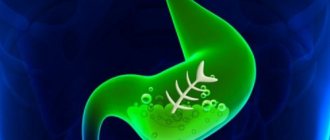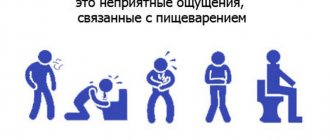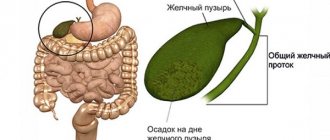Causes
It is worth taking into account that the digestive system of children 2-3 years of age is most sensitive to overload.
Causes of dyspepsia found in children
| Improper feeding in infancy | Innate characteristics of the body | Violation of the principles of rational nutrition | Lack (relative or absolute) of enzymes | Other |
| Violation of the diet by a nursing mother (highly allergenic and irritating foods) | Prematurity | Ignoring age-related nutrient needs and energy value of food | Fermentative dyspepsia. It occurs when carbohydrates entering the body are not completely digested in the small intestine and are fermented by microflora. | Violation of the infant's motor pattern. This refers to tight swaddling the old school way. Modern pediatricians recommend providing the child with maximum freedom of movement. |
| Low birth weight | ||||
| Exceeding the age-specific volume of the formula by 10-20% (the walls of the gastrointestinal tract (GIT) of an infant are stretched too much, and he feels discomfort) | Immunodeficiency conditions | |||
| Feeding the child foods that are difficult to digest: lard, lamb, sausages, fatty pork, mushrooms | ||||
| Neurological disorders | ||||
| Congenital malformations | ||||
| Rickets | ||||
| Using formulas that are not age-appropriate | Anemia | Lack of meal routine | Steatorrhea. Occurs due to excess fat. They are not absorbed by the body and are excreted in the feces. | Psychosomatics Some problems (tensed relationships in the family, the child’s lack of a sense of security and acceptance, manipulating him with food). |
| Feeding the baby with cow's milk or fermented milk products (the gastrointestinal tract is not mature enough) | ||||
| Overeating (when parents force you to finish everything on your plate) | ||||
| Putrid dyspepsia. An excess of protein that is difficult to break down becomes a substrate for rotting. | ||||
| Early introduction of complementary foods (up to 6 months). Foreign and unusual food will irritate the fragile walls of the gastrointestinal tract. |
Treatment
The main goal of treatment is to improve the general well-being of the patient, eliminate pain and other symptoms. The therapeutic regimen includes the following activities:
- correction of lifestyle and nutrition;
- medications;
- psychotherapy.
Meals must be in small portions, six times a day. You should give up fatty foods, spices, coffee, strong tea, limit the consumption of alcoholic beverages, and quit smoking. If possible, you should limit your intake of medications that irritate the stomach, such as NSAIDs.
Drug treatment includes the following groups of drugs:
- Gastroprotectors (Rebagit). They protect the gastrointestinal mucosa from damage, enhance mucus synthesis, and improve microcirculation.
- Prokinetics (Itomed). Strengthen peristalsis of the esophagus and stomach, improve emptying of the latter. Indicated for feelings of early satiety, heaviness and distension in the stomach.
- Antisecretory drugs (Omeprazole, Lansoprazole). Effective for pain, sour belching.
- Enzymes (Mezim, Creon). Prescribed for complaints of discomfort and heaviness in the epigastrium due to pancreatic secretory insufficiency.
The duration of treatment is determined by the general condition of the patient and the severity of complaints. Combination therapy with prokinetics, enzymes, and, if indicated, antisecretory agents is effective.
Some experts recommend including antidepressants in the treatment regimen. Sometimes various forms of psychotherapeutic correction, for example, cognitive therapy, have a good effect.
Classification
Digestive disorders are divided into types according to causes and main manifestations. Simple dyspepsia in children occurs in the absence of an anatomical defect. It can progress to more severe forms.
| View | Characteristic | Causes |
| Organic | Occurs due to structural abnormalities | Stomach ulcer, cholecystitis, pancreatitis, biliary dyskinesia |
| Toxic | Dehydration and intoxication are added | Intestinal infections |
| Parenteral | Accompanies infectious diseases of extraintestinal localization | Penetration of microorganism toxins into the blood |
| Functional | ||
| Simple | Gastrointestinal dysfunction | Child feeding disorders |
| Ulcerative | Pain in the epigastric region | Disturbance of neurohumoral regulation of motor function of the upper gastrointestinal tract |
| Reflux-like | Belching, vomiting, bloating | |
| Dyskinetic | Discomfort in the abdomen after eating, increased formation of gases | |
| Nonspecific | Does not belong to any of the above species | |
Non-ulcer dyspepsia in children
IN
In recent years, the problem of non-ulcer or functional dyspepsia (ND) has been discussed in domestic and foreign literature.
To define this symptom complex - various dyspeptic disorders and a state of discomfort in the upper abdomen - many terms have been proposed: idiopathic, inorganic, essential dyspepsia, which brings certain difficulties to the work of practitioners. This is explained by different methodological approaches to defining both the concept itself and the diagnosis of non-ulcer dyspepsia syndrome [1,2,3].
According to modern concepts, non-ulcer
(functional)
dyspepsia
is a syndrome that includes: pain in the upper abdomen, dependent on food intake and/or not associated with it, periodically occurring after physical activity or emotional stress; a feeling of heaviness in the epigastric region, flatulence, nausea, vomiting, heartburn and regurgitation. In this case, various organic diseases of the gastrointestinal tract (GIT) should be excluded: peptic ulcer of the stomach and duodenum, gastroesophageal disease, cholecystitis, pancreatitis, malformations and other diseases.
A number of researchers classify Helicobacter-positive chronic gastritis and gastroduodenitis as non-ulcer dyspepsia [4,5,6]. Our experience allows us to agree with other gastroenterologists who believe that chronic gastritis and gastroduodenitis are diseases with characteristic morphofunctional changes in the mucous membrane, and it is not legitimate to classify them as ND syndrome.
It is generally accepted that functional disorders are not accompanied by gross morphological changes in organs and tissues. The need to identify functional disorders in a pediatric clinic is justified by the characteristics of critical periods of child growth and development, and the state of adaptation and regulatory systems. Any functional disorders are the initial manifestations of a chronic process, including in the digestive system.
The prevalence of dyspeptic disorders in adults and children is quite high - from 20 to 50%. However, it is difficult to establish exact figures in children without conducting clinical and epidemiological studies, since all gastroenterological diseases in children occur with symptoms of dyspepsia of varying severity. Functional disorders of the digestive tract manifest themselves in a wide range of symptoms and are detected in the majority of children referred for consultation to a gastroenterologist.
Classification
The clinical symptoms of ND are characterized by a wide polymorphism of symptoms. There are four forms of ND: ulcer-like, reflux-like, dyskinetic and nonspecific [7,8,9].
For ulcer-like form
characterized by an “irritated” stomach, pain in the epigastric region before meals, sometimes at night, disappearing after eating and antacids.
With the reflux-like form,
patients are bothered by regurgitation, belching, heartburn, vomiting, and a feeling of “acid in the mouth.”
For the dyskinetic variant
(“sluggish stomach”), typical sensations of heaviness, fullness after eating, nausea, rapid satiety, vomiting, flatulence, intolerance to fatty, dairy and other types of food.
The nonspecific form
of ND is manifested by a combination of symptoms that are difficult to attribute to one or another form of dyspepsia.
Etiology and pathogenesis
The causes of ND can be emotional stress, mental trauma, disturbances in rhythm and diet, physical overload, early alcohol consumption, smoking, and exposure to man-made factors of environmental pollution [10,11,12,13].
Dyspeptic disorders often occur against the background of other diseases of the digestive tract, parasitic infections, endocrine pathology (diabetes mellitus, diseases of the thyroid gland and adrenal glands). In some children, symptoms of ND appear after taking medications or food allergies.
The decisive role in the development of ND is played by motility disorders of the upper gastrointestinal tract, which in children is manifested by incoordination of the gastroduodenal complex in the form of refluxes, insufficiency of the sphincter apparatus, various combinations of hypo- and hyperkinetic and tonic dyskinesias [14,15]. This is to a certain extent due to a violation of autonomic innervation and neurohumoral regulation. The intensity of ND symptoms in children is influenced by the level of acid formation. The significance of the degree of contamination of the mucous membrane with Helicobacter pylori (HP) in the occurrence of disturbances in the motor function of the stomach is considered controversial.
The prevalence of HP infection currently remains high; in developing countries, 80% of the population is infected by 10 years of age, which significantly increases the risk of developing certain gastrointestinal diseases. Wider detection and treatment of Helicobacter pylori infection may be considered appropriate, including in asymptomatic carriers. Primary infection with HP most often occurs at the age of 3–4 years. The detection rate of antibodies to HP is 44% in children and 88% in adults. In school-age children (7–18 years), HP infection occurs in manifest (63%) and latent (37%) forms; the frequency of latent forms increases with age. The nature of complaints does not depend on the degree of HP infection [6,10,16].
In some children, ND is combined with irritable bowel syndrome, which is manifested by abdominal pain, alternating diarrhea and constipation, a feeling of incomplete bowel movement, neurogenic bladder, and vegetative-vascular dystonia.
Diagnosis
To confirm non-ulcer (functional) dyspepsia, organic gastrointestinal pathology should be excluded: gastric and duodenal ulcers, chronic gastritis and gastroduodenitis, reflux esophagitis, cholelithiasis, chronic pancreatitis, neoplasms, liver diseases and other diseases.
This requires a set of laboratory and instrumental studies, which is advisable to start with non-invasive methods. It should be emphasized that in the process of diagnosing ND, the most complete information can be obtained by studying the anamnesis and analyzing the clinical symptoms of the disease in combination with the correct interpretation of the examination results.
The volume of research in the process of diagnosing “functional disorders” often exceeds the number of studies when making a topical diagnosis. This is due, first of all, to the doctor’s doubts about the examination results, which affects the relationship with the patients’ parents. At the same time, it is more important for the patient to get rid of unpleasant symptoms and not subject himself to tedious, invasive diagnostic procedures.
Diagnosis should be based on a detailed history of life and illness, clarification of hereditary factors, socio-economic and psychological nuances of the child’s life. Therefore, in our opinion, the complex of examinations must be reduced to a minimum: non-invasive research methods should be predominantly used in children, especially at the prehospital stage.
Non-invasive and minimally invasive methods:
• Ultrasound examination of the abdominal organs with cholecystoscopy
• Breath tests to detect HP
• Coproscopy
• Fecal occult blood test
• General blood analysis
• Determination of pancreatic enzyme activity in blood and urine
• Biochemical tests to exclude syndromes of hepatic cell failure, cytolysis, cholestasis.
If symptoms of “anxiety” are detected, such as an increase in ESR, anemia, blood in the stool, fever, weight loss, etc., an in-depth study in a hospital is indicated.
Instrumental and laboratory methods (II order):
• Endoscopic examination (esophagogastroduodenoscopy) with targeted biopsy of the mucosa
• Intragastric pH-metry, 24-hour monitoring as indicated
• X-ray examination
• Serological test for the presence of antibodies to HP (if HP is not detected in the biopsy).
Treatment
Approaches to therapy are determined by the leading clinical manifestations and the form of ND. If there are good social and living conditions, sick children should be treated on an outpatient basis.
Important importance in the treatment program is given to organizing the regime, normalizing the rhythm of sleep and wakefulness, the principles of rational nutrition in compliance with dietary recommendations, eliminating stressful situations, and streamlining physical activity.
An individual approach to a patient with functional dyspepsia is the key point of therapy. It is advisable to start it with psychotherapeutic correction, and in case of persistent chronic course it is necessary to involve specialists - a neuropsychiatrist, a psychotherapist. As our clinical experience shows, often even a change in the environment already has a beneficial effect on the course of the disease.
Taking into account modern ideas about the leading role of the motor-evacuation function of the stomach and duodenum in ND, most researchers consider the prescription of prokinetics to be the means of choice in the treatment of patients [9,15,17]. This group includes the dopamine receptor blocker domperidone and the serotonin receptor activator cisapride. Currently, the use of the dopamine antagonist metoclopramide is limited due to severe side effects in the form of extrapyramidal reactions and prolactinemia. Unlike metoclopramide, domperidone and cisapride do not have these side effects.
Domperidone increases the tone of the lower esophageal sphincter, enhances peristalsis, accelerates gastric emptying, improves anthro-duodenal coordination; extrapyramidal symptoms occur very rarely when prescribed. Cisapride restores motor function of the upper gastrointestinal tract by activating serotonin receptors, releasing acetylcholine, with virtually no side effects [7,9,12]. Another no less effective drug that normalizes the motor activity of the digestive tract is trimebutine, an antagonist of opiate receptors. Trimebutine does not change normal motor skills and is prescribed to children from the first year of life. Effective in the treatment of concomitant irritable bowel syndrome.
Prokinetics are well tolerated by patients and can be used both in hospital and clinic settings. Often these drugs are used as monotherapy, which significantly reduces the drug burden on a sick child.
For the ulcer-like variant of ND, antisecretory drugs are indicated - histamine H2-blockers (famotidine, ranitidine), proton pump inhibitors (omeprazole), when there is proven hyperacidity.
In case of a nonspecific variant of ND, symptomatic therapy is prescribed taking into account clinical manifestations, their frequency and intensity, and prokinetics according to indications. Insoluble antacids and cytoprotectors can be included in the complex of therapy.
In Helicobacter-positive patients with ND, it is recommended to carry out eradication therapy using bismuth-containing drugs in combination with metronidazole and an antibiotic (clarithromycin, amoxicillin, tetracycline) or furazolidone, since the lack of eradication in such children threatens the development of peptic ulcer disease [4,5,6, 16].
In the presence of exocrine pancreatic insufficiency, the use of enzyme preparations (digestal, etc.) is indicated.
Taking into account the tendency of ND to recur, the therapeutic program takes quite a long time and is not limited to one course of drug therapy; its positive effect should be consolidated by rehabilitation measures: physiotherapy, physical therapy complexes, sanatorium-resort treatment.
Thus, when diagnosing “non-ulcer dyspepsia syndrome,” the doctor must remember that this symptom complex may hide a certain nosological form that requires clarification and appropriate dynamic monitoring.
Literature:
1. Jones R., Lydeards S Prevalence of symptoms of dyspepsia in the community // RMJ 1989; 298:30–2.
2. Tatley N, Silverstein M, Agreus L et al. // Evaluation of dyspepsia. Gastroenterology, 1998; 114:582–95.
3. Vantrappen G. Gastrointestinal motility.// World Gastroenterology.-April.1999; 11–4.
4. Mazurin A.V. Syndrome of “non-ulcer dyspepsia” // Russian Pediatric. zhur., 1998; 4:48–53.
5. Chernova A. A. Differential diagnosis of non-ulcer dyspepsia syndrome in children./Abstract... cand. diss. M., 1998; 23.
6. Lam SK The role of Helicobacter pylory in functional dyspepsia. —Ibid. 42–3.
7. Champion MS, Mac.Cannel KL Thomson AB et al. A double-blind, randomized trial of cisapride in the treatment of non-ulcer dyspepsia. //Can. J. Gastroenterol. 1977; 11: 127–34.
8. Nandurkar S, Talley NJ Xia H et.al. Dyspepsia in the community is linked to smoking and aspirin use bat not to Helicobacter pylory infection. //Arch. Intern. Hed. - 1998; 158:1427–33.
9. Sheptulin A.A. Modern principles of treatment of dyspeptic disorders // Practitioner. 1999; 16:8.
10. Malaty H., Paycov V., Bykova O. et al. Helicobacter pylori and socioeconomic factors in Russia. Helicobacter, 1996; 1 (2): 82–7.
11. Koch KL Motility disorders of the stomach. // Innovation towards better GJ care 1. Janssen -Cilag congress Abstracts.- Madrid., 1999; 20–1.
12. Diseases of the digestive system in children./ Ed. A.A. Baranova, E.V. Klimanskaya, G.V. Rimarchuk. -M., 1996; 310.
13. Richter J. Stress and psychological and environmental factors in dyspepsia. // Scand. J. Gastroenterol., 1991; 26:40–6.
14. Kasumyan S.A., Alibegov R.A. Functional and organic disorders of the patency of the duodenum. Smolensk 1997; 134.
15. Achem SR, Robinson MA Prokinetic Approach to Treatment of Gastroesophageal Reflux Disease. //Dig. Dis. 1988; 16:38–46.
16. Akimov AA Prevalence and clinical and endoscopic comparisons of Helicobacter pylori infection in school-age children. Author's abstract... cand. diss. St. Petersburg. 1999; 21.
17. Vasiliev Yu.V. Coordinax in the treatment of gastroesophageal reflux disease.// Ros. zhur. gastroenterol., hepatol., coloproctol. 1998; VIII (3): 23–6.
Enzyme preparation –
Digestal (trade name)
(ICN Pharmaceuticals)
Omeprazole –
Gastrozol (trade name)
(ICN Pharmaceuticals)
Symptoms
Signs of dyspeptic disorder are:
| Symptoms | Definition | Causes | Features in children |
| Pain in the pit of the stomach, in the midline | The child perceives it as an unpleasant sensation, as if tissue is being damaged | Hypersensitivity of the stomach walls to stretching | Children can show the exact localization of pain at 5-7 years old |
| Discomfort in the abdomen | Subjectively unpleasant feeling, but not intense enough | The child may react with whining, tearfulness, and irritability. | |
| Regurgitation | Return of some ingested milk or formula | Typical for children in the first year of life | |
| Fast saturation | A feeling that the stomach is full almost immediately after starting to eat. | Slow movement of gastrointestinal contents | Children refuse to eat, do not finish food off their plates, and are naughty |
| Decreased appetite | Refusal to eat in the usual quantities for the child | In infants: refusal to latch onto the breast, sluggish sucking, as if in a dream | |
| Stomach fullness | Unpleasant feeling of food retention in the stomach, occurs after meals or in the interval between them | The child most often reacts with moodiness and anxiety for which there is no apparent reason | |
| Belching | Passage of air masses after eating, sometimes with an unpleasant odor | Excessive air swallowing due to improper feeding | Often accompanied by regurgitation. In older children, it may be a manifestation of fermentation processes in the intestines. |
| Bloating in the epigastrium | Feeling of fullness in the upper abdomen, almost right under the ribs | Activation of the vital activity of microorganisms, manifested by biochemical reactions of decomposition of proteins or carbohydrates | Due to the small amount of subcutaneous fatty tissue, children may experience a protrusion in this area |
| Flatulence and flatulence | Formation and release of gases in the intestines, often with an unpleasant odor | To relieve symptoms of dyspepsia in infants, a gas outlet tube may be needed. | |
| Nausea | Lightheadedness, premonition of vomiting | Due to the immaturity of the nerve centers in children, it is often accompanied by concomitant tachycardia. | |
| Tenesmus | Painful urge to defecate, may precede bowel movements or have no logical conclusion | The effect of microorganism toxins on the nerve plexuses of the intestines | In newborns the equivalent is crying and kicking their legs. |
| Stool changes | Liquefaction | Decreased absorption, increased mucus production | If the child is small, then the nature of the feces is monitored by the contents of the diaper or potty. Older children need to be explained the cause of the disturbances, taught to evaluate their stool, and if there are changes, talk to their mother about them. |
| Yellow or greenish color | Changes in the biochemical composition of feces | ||
| Additional inclusions: lumps of undigested food, mucus | Digestive enzyme deficiency | ||
| Steatorrhea | Presence of undigested fats in stool | ||
| Defecation more than 5 times a day | Strengthening gastrointestinal motility |
Dyspepsia in young children usually begins with the child's restlessness, regurgitation, decreased appetite and increased bowel movements.
Diagnosis of dyspepsia
Before starting treatment for dyspepsia, it is necessary to undergo an examination, which includes not only a description of complaints, an external examination, but also the following:
- laboratory tests - general and biochemical blood tests, examination of stool for the presence of blood, coprogram;
- instrumental studies - a test for gastric acid secretion, esophagogastroduodenoscopy, examination of gastric materials for the presence of Helicobacter pylori, ultrasound of the abdominal organs, colonoscopy, radiography, computed tomography, esophageal and antroduodenal manometry.
You can undergo diagnostics at JSC "Medicine" (clinic of Academician Roitberg), which is located in the central district of Moscow, near the Tverskaya, Novoslobodskaya, Belorusskaya, Chekhovskaya metro stations. If you have a disease, you may need to consult not only a gastroenterologist, but also other specialists: a psychiatrist, neurologist, cardiologist, endocrinologist.
Prevention
Research shows that with proper care, the symptoms of functional dyspepsia disappear. In the first months of life, children require special control over their nutrition:
- The most physiological option is breastfeeding on demand. In this case, the mother's diet is subject to control.
- When artificial feeding, a number of rules must be taken into account:
- calculate the volume of the mixture according to the age of the child;
- use only adapted products;
- Follow the cooking instructions exactly.
- Lure. Pediatricians recommend introducing it starting at 6 months. It is necessary to follow the scheme approved by them in order to facilitate the child’s transition to “adult” food.
To level out dyspeptic symptoms, older children need to adhere to the following rules:
- have a diet;
- avoid eating dry foods;
- adhere to the principles of rational nutrition.
If the symptoms worsen, the doctor may prescribe a water-tea break to cleanse the intestines of toxic products and take away the nutrient substrate from the bacteria.
Types of disease and causes
Dyspepsia is divided into:
- functional;
- nutritional;
- toxic;
- organic.
Indigestion can occur both as a result of improper nutrition and as a result of poisoning the body with toxins, in which case treatment in a hospital may be required.
With dyspepsia, as a rule, symptoms such as belching, nausea, bloating, loss of appetite, diarrhea are observed.
Simple (functional)
Simple, or functional, dyspepsia in children occurs due to improper enzymatic activity of the endocrine glands, motor skills disorders and problems of the nervous system.
Subtypes of functional dyspepsia:
- ulcer-like;
- dyskinetic;
- nonspecific.
Nutritional
The development of the nutritional form of the disease is provoked by nutritional disorders: systematic overeating, eating poorly prepared or stale foods.
Reasons for the development of dyspepsia in infants:
- overfeeding;
- non-compliance with the rules for introducing complementary foods;
- lack of diet.
Fermentative, putrefactive and other forms of nutritional dyspepsia: table
| View | Characteristic | Eating disorders |
| Fermentation | Characterized by a lack of pancreatic juice components involved in the breakdown of carbohydrates. As a result, food is not completely digested. Consequences:
| Excessive or unbalanced consumption of foods such as:
|
| Putrid |
|
|
| Fat |
| Including foods containing saturated fats (lamb, pork) in the diet. |
Toxic
Toxic dyspepsia is a nutritional complication that occurs in children under one year of age. It begins as a digestive disorder, which results in intoxication of the gastrointestinal tract: harmful substances enter the blood, which leads to poisoning of the entire body. This has a negative effect on the nervous system, and metabolism suffers.
The role of provoking factors is not only dietary errors, but also infection with microbes.
Organic
Organic dyspepsia is a secondary digestive disorder. Caused by a disease that is infectious in nature or is the result of damage to any organ. Toxins (the causative agents of the underlying pathology) affect the autonomic nervous system, as a result of which it ceases to cope with the regulation of the digestive system. Consequences of this process:
- acceleration of peristalsis;
- decreased bile secretion;
- decline in enzyme activity;
- changes in absorption processes in the intestine.











